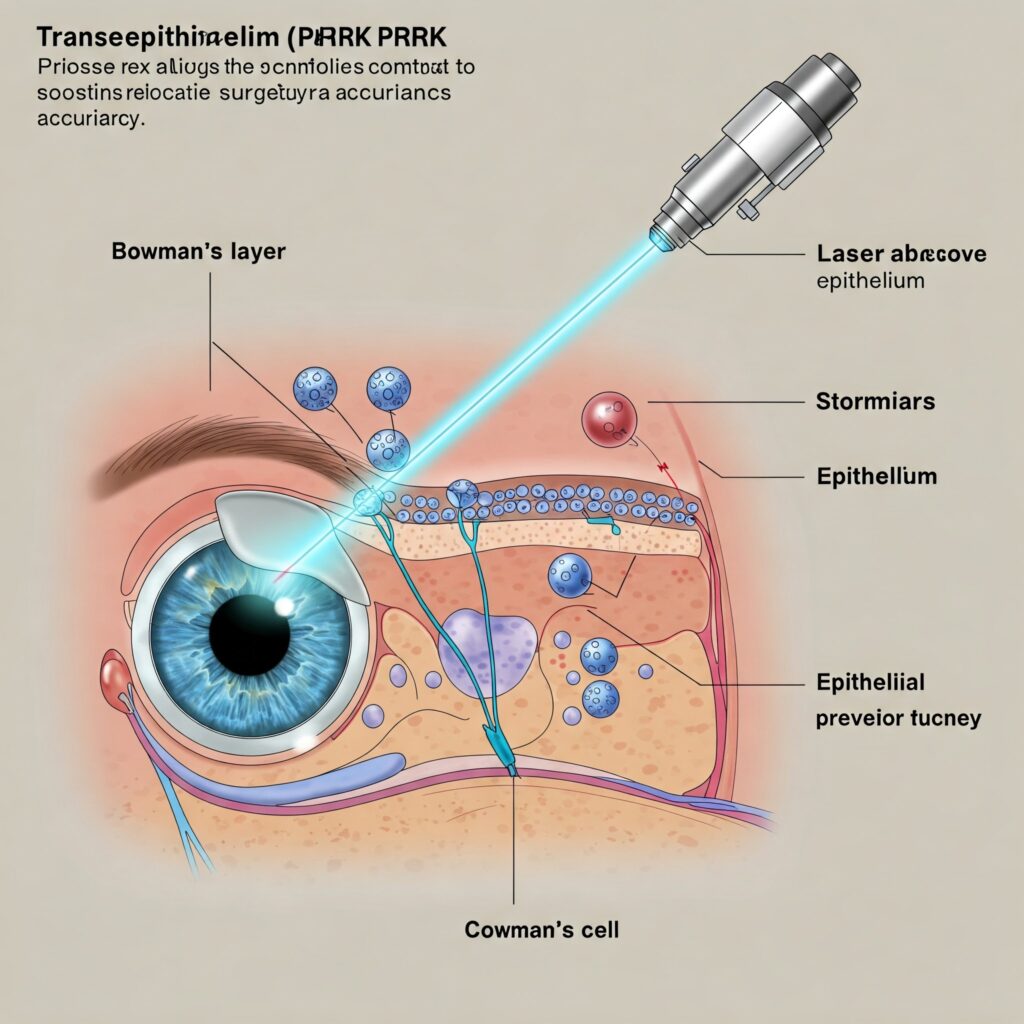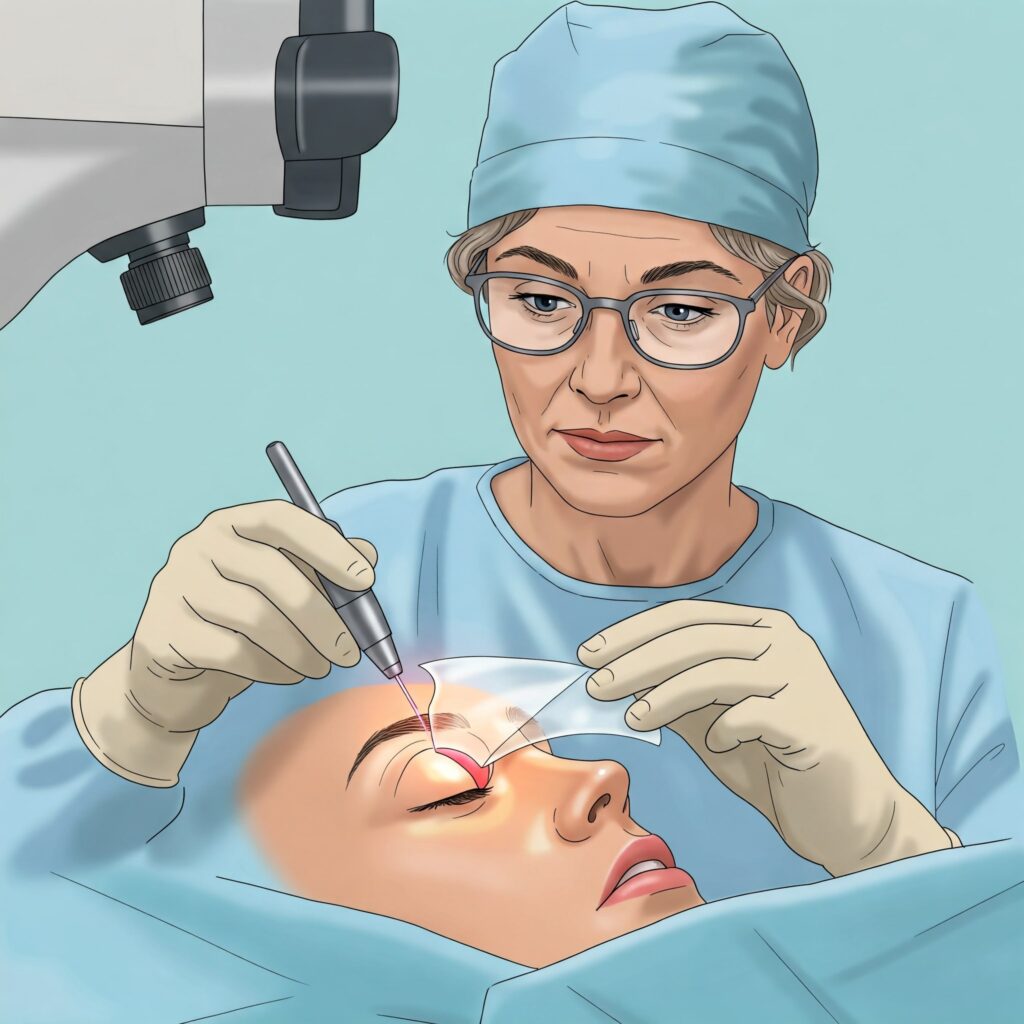Imagine waking up one morning, the world a blurry haze, your glasses missing, your contacts nowhere to be found. You squint, strain, and stumble through your day, desperate for clarity. Now, picture a choice—a life-altering decision that could banish that blur forever.
Two paths stand before you: PRK vs LASIK. Both promise sharper vision, a life free from lenses, but each hides secrets, risks, and rewards that could change everything. Which is safer? Which is right for you? The clock is ticking, and your vision hangs in the balance.
Native AsyncIn 2025, the PRK vs LASIK debate is more intense than ever, fueled by cutting-edge laser technology and a growing demand for perfect sight. These procedures—Photorefractive Keratectomy (PRK) and Laser-Assisted In Situ Keratomileusis (LASIK)—have transformed millions of lives, but they’re not created equal.

From surgical techniques to recovery times, candidacy to long-term safety, the differences are stark, and the stakes are high. One wrong move, and you could face complications that linger for years. One right choice, and you could see the world with breathtaking clarity.
Buckle up as we unravel the seven key differences between PRK vs LASIK, diving deep into the science, the stories, and the secrets of 2025’s most popular vision correction surgeries. By the end, you’ll know exactly which path to take—and why it could be the most important decision of your life.
What Are PRK and LASIK?
Before we plunge into the heart of PRK vs LASIK, let’s pull back the curtain on these procedures. Both are laser-based refractive surgeries designed to fix common vision issues—nearsightedness (myopia), farsightedness (hyperopia), and astigmatism—by reshaping the cornea, the eye’s clear front surface. But their methods? Night and day.
- PRK (Photorefractive Keratectomy): The pioneer of laser vision correction, PRK emerged in the 1980s. It strips away the cornea’s outer layer (epithelium) to expose the tissue beneath, then uses an excimer laser to sculpt it into the perfect shape for clear vision. The epithelium grows back naturally, but the process isn’t painless—or quick.
- LASIK (Laser-Assisted In Situ Keratomileusis): Born in the 1990s, LASIK is the sleek, modern cousin. It starts with a thin corneal flap, created by a blade or femtosecond laser, which is lifted to allow the excimer laser to work its magic. The flap is then laid back down, acting like a natural bandage. Fast, flashy, but not without its shadows.
Both aim for the same prize—crystal-clear vision—but the journey differs dramatically. Let’s dive into the seven key differences in PRK vs LASIK that could make or break your decision.
Native Async
Surgical Technique: Flap vs. No Flap
The first twist in the PRK vs LASIK saga is how they approach the cornea. One creates a flap; the other doesn’t. This single difference sets the stage for everything that follows.
- LASIK: Picture a surgeon wielding a laser with surgical precision, carving a paper-thin flap in your cornea. This flap, lifted like a trapdoor, exposes the corneal tissue for reshaping. Once the excimer laser does its job, the flap is gently repositioned, sticking naturally without stitches. It’s fast, minimally invasive, and feels like a miracle—until you consider the catch. That flap is permanent, a potential weak point vulnerable to trauma or complications, especially if you’re a boxer, a firefighter, or just clumsy.
- PRK: PRK takes a bolder approach. No flap, no finesse—just raw exposure. The surgeon removes the cornea’s entire outer layer, either with a tool or a diluted alcohol solution, leaving the corneal tissue bare for the laser’s work. The epithelium regenerates over days, but the process is gritty, raw, and not for the faint of heart. Yet, without a flap, there’s no risk of flap-related disasters, making PRK a fortress for certain lifestyles.
Why It Matters: The flap in LASIK is a double-edged sword—speedy recovery but a lifelong risk. PRK’s no-flap approach trades short-term pain for long-term stability. Which can you live with? The answer lies in your daily life and tolerance for risk.
Recovery Time: Blink vs. Endurance
Recovery is where PRK vs LASIK pulls you in opposite directions, testing your patience and priorities.
- LASIK Recovery: LASIK is the sprinter of the two. Within 24–48 hours, most patients are marveling at their newfound clarity, with minimal discomfort. The corneal flap acts like a shield, keeping pain at bay and letting you dive back into work, driving, or Netflix binges almost immediately. But there’s a catch: that flap needs babying. Rub your eyes too soon, or take a stray elbow playing basketball, and you could dislodge it, plunging you into a nightmare of emergency surgery.
- PRK Recovery: PRK, on the other hand, is a marathon. The removal of the epithelium leaves your cornea exposed, leading to 3–5 days of stinging pain, light sensitivity, and blurry vision as the epithelium regrows. A bandage contact lens helps, but don’t expect to feel human right away. Full visual sharpness can take weeks, sometimes months, testing your endurance. Strenuous activities? Off-limits for at least two weeks.
Why It Matters: If your life demands a quick comeback, LASIK’s speed is seductive. But if you can grit your teeth through a tougher recovery for a potentially sturdier outcome, PRK might be your champion. How much downtime can you afford?

Candidacy: Who Gets to Play?
Not everyone can step into the PRK vs LASIK arena. Your eye’s anatomy and lifestyle dictate whether you’re a contender.
- LASIK Candidacy: LASIK loves thick, healthy corneas, as the flap requires enough tissue to work with. You’re a prime candidate if you’re over 18, have stable vision for a year, and lack conditions like severe dry eye or keratoconus. But thin corneas, irregular shapes, or sky-high prescriptions? They could disqualify you, as the flap might weaken your cornea too much.
- PRK Candidacy: PRK is the underdog’s hero. It’s perfect for those with thinner corneas, irregular surfaces, or prescriptions that push LASIK’s limits. Since there’s no flap, PRK preserves more corneal tissue, making it safer for borderline cases. It’s also the go-to for adrenaline junkies—think MMA fighters, soldiers, or surfers—whose eyes might take a beating.
Why It Matters: Your cornea’s thickness and your lifestyle are the gatekeepers. In 2025, advanced diagnostics like corneal topography and AI-driven scans make candidacy assessments razor-sharp, ensuring you’re matched with the right procedure. A thorough exam is your ticket to clarity.
Safety Profile: Playing the Long Game
Safety is the pulse of the PRK vs LASIK decision. Both procedures boast impressive success rates, but their risks cast different shadows.
- LASIK Safety: LASIK is a safe bet, with complications in less than 1% of cases. The flap, though, is its Achilles’ heel. Rare but real risks include flap dislocation, epithelial ingrowth (cells creeping under the flap), or infections. These are nightmares for athletes or anyone whose eyes might face trauma. Long-term, the flap slightly weakens the cornea, raising a faint specter of issues like ectasia (corneal bulging).
- PRK Safety: PRK sidesteps flap drama, making it a fortress for high-risk lifestyles. But it’s not flawless. Removing the epithelium can lead to corneal haze, a cloudy scar that blurs vision, especially in high-prescription cases. Thankfully, 2025’s mitomycin-C treatments have slashed this risk. PRK also preserves more corneal tissue, lowering the odds of ectasia, especially for thinner corneas.
Why It Matters: Both PRK vs LASIK shine in 2025, thanks to refined lasers and stricter protocols. PRK edges out for those dodging flap risks, while LASIK’s low immediate complication rate wins fans. Your surgeon’s skill and your risk tolerance will tip the scales.

Visual Outcomes: Clarity or Compromise?
The ultimate prize in PRK vs LASIK is crystal-clear vision. But do both deliver equally?
- LASIK Visual Outcomes: LASIK is a showstopper, delivering sharp vision often within hours. Over 95% of patients hit 20/20 or better, with glowing reviews. Side effects like glare, halos, or dry eyes can linger, especially at night, but they usually fade. The catch? Those with large pupils or high prescriptions may notice more quirks.
- PRK Visual Outcomes: PRK plays the long game. Early days bring blurry vision and light sensitivity, with full clarity taking weeks or months. Yet, studies show PRK matches LASIK’s 20/20 success rate over time. Haze, once a concern, is rare with modern techniques, and side effects mirror LASIK’s, fading with patience.
Why It Matters: In 2025, PRK vs LASIK are neck-and-neck for visual outcomes, thanks to wavefront-guided lasers and AI-optimized treatments. Your surgeon’s expertise and your eye’s unique quirks will shape the results. Expect excellence, but brace for a different timeline.
Native AsyncCost: What’s the Price of Sight?
Money talks, and PRK vs LASIK comes with a price tag that demands attention.
- LASIK Cost: In 2025, LASIK runs $2,000–$3,500 per eye, depending on the clinic, technology (bladeless is pricier), and location. The flap’s complexity and quick recovery justify the cost, but financing plans and package deals make it accessible. Hidden costs? Follow-ups are minimal, but complications could add up.
- PRK Cost: PRK is slightly cheaper, at $1,800–$3,200 per eye. No flap means less equipment, but the longer recovery might mean extra visits or meds. Clinics sometimes discount PRK for thin-cornea patients, but don’t skimp on quality for savings.
Why It Matters: PRK vs LASIK costs are close, so focus on value, not just price. Beware bargain-basement deals—they often signal outdated tech or rookie surgeons. Free consultations and financing options are your allies in 2025.
ANTI-ADBLOCK JS SYNCTechnological Advancements: The Future Is Now
In 2025, PRK vs LASIK is a high-tech showdown, with innovations pushing both to new heights.
- LASIK Advancements: Bladeless LASIK, powered by femtosecond lasers, is king, crafting flaps with microscopic precision. Wavefront and topography-guided treatments tailor the laser to your eye’s quirks, slashing side effects. AI-driven diagnostics predict outcomes, ensuring your flap is perfect every time.
- PRK Advancements: PRK’s glow-up includes transepithelial PRK (TransPRK), where the laser removes the epithelium, boosting accuracy. Mitomycin-C zaps haze risks, and next-gen excimer lasers sculpt smoother corneas. AI corneal mapping makes PRK a bespoke masterpiece.
Why It Matters: Technology has leveled the PRK vs LASIK playing field, making both safer and sharper. A clinic with 2025’s latest gear and a surgeon who knows it inside out is non-negotiable.
Which Is Safer for You?
The PRK vs LASIK crossroads demands a choice. Here’s your compass:
- Choose LASIK If:
- You crave instant results and minimal downtime.
- Your corneas are thick and healthy.
- Your lifestyle avoids eye trauma (no cage fighting, please).
- You’re okay with a permanent flap.
- Choose PRK If:
- Your corneas are thin or irregular.
- You live for high-contact sports or risky jobs.
- You’ll trade short-term pain for long-term peace of mind.
- Flap risks keep you up at night.
Safety Verdict: Both PRK vs LASIK are safe in skilled hands, with PRK edging out for high-risk lifestyles and LASIK shining for low-risk patients. A meticulous preoperative exam is your safeguard.
Your Next Step
The PRK vs LASIK mystery isn’t solved in a vacuum. Book a consultation with a board-certified ophthalmologist who lives and breathes refractive surgery. They’ll map your corneas, test your eyes, and lay bare your options. Ask:
- Which procedure fits my eyes and lifestyle?
- What risks are unique to me?
- What tech do you use, and why does it matter?
- How will recovery impact my life?
In 2025, virtual consults and AI simulations make exploring PRK vs LASIK easier than ever. Don’t rush—your vision deserves precision, not haste
The PRK vs LASIK saga is a thrilling ride, with twists of technology, risks, and rewards. LASIK dazzles with speed and instant clarity, perfect for those with thick corneas and calm lifestyles. PRK, the gritty warrior, offers resilience for thinner corneas and high-octane lives, demanding patience but delivering strength.
Armed with the seven key differences—technique, recovery, candidacy, safety, outcomes, cost, and tech—you’re ready to choose. PRK vs LASIK isn’t just a procedure; it’s a leap toward a clearer future. Find a trusted surgeon, embrace the journey, and step into 2025 with eyes wide open.
PRK vs LASIK Cost
In 2025, PRK vs LASIK costs are similar, with LASIK ranging from $2,000–$3,500 per eye and PRK from $1,800–$3,200 per eye. LASIK may be slightly pricier due to flap creation, but prices vary by clinic, technology, and location. Check for financing options during consultations.
PRK vs LASIK vs SMILE
PRK vs LASIK involves removing the epithelium (PRK) or creating a flap (LASIK) to reshape the cornea. SMILE (Small Incision Lenticule Extraction) uses a femtosecond laser to create a lenticule inside the cornea, removed through a tiny incision. SMILE is less invasive than LASIK, with no flap, but PRK is better for thin corneas. All correct myopia and astigmatism, but candidacy and recovery differ—consult your surgeon.
PRK vs LASIK Astigmatism
Both PRK vs LASIK effectively correct astigmatism by reshaping the cornea to fix irregular curvature. Modern wavefront-guided lasers in 2025 ensure high precision for both procedures. PRK may be preferred for severe astigmatism with thin corneas, while LASIK works well for milder cases. Your surgeon’s evaluation will determine the best fit.
PRK vs LASIK Recovery Time
PRK vs LASIK recovery times differ significantly. LASIK offers clear vision within 24–48 hours, with minimal discomfort, allowing a return to most activities in days. PRK recovery takes 3–5 days for initial healing, with full clarity in weeks or months, due to epithelium regrowth. LASIK is faster, but PRK’s recovery is more gradual.
PRK vs LASIK Complications
In PRK vs LASIK, LASIK risks include flap issues (dislocation, ingrowth) and dry eyes, with a <1% complication rate. PRK avoids flap problems but may cause corneal haze or prolonged discomfort, though mitomycin-C reduces haze risk. Both are safe in 2025, but PRK suits high-risk lifestyles, while LASIK’s risks are minimal with proper care.
PRK vs LASIK vs ICL
PRK vs LASIK reshapes the cornea for vision correction, ideal for mild to moderate prescriptions. ICL (Implantable Collamer Lens) involves placing a lens inside the eye, suitable for high prescriptions or thin corneas where PRK/LASIK aren’t options. ICL is reversible but invasive, with risks like cataract formation. Your eye health dictates the best choice.
Is PRK Safer Than LASIK?
In PRK vs LASIK, PRK is often safer for those with thin corneas or high-risk lifestyles (e.g., athletes), as it avoids flap complications. LASIK is safe for most, with a low complication rate, but the flap poses rare risks. Both are highly safe in 2025 with modern tech—safety depends on your eye profile and surgeon’s expertise.
PRK vs LASIK Long-Term
Long-term, PRK vs LASIK outcomes are comparable, with over 95% of patients achieving 20/20 vision. PRK preserves more corneal tissue, reducing ectasia risk, ideal for thinner corneas. LASIK’s flap may weaken the cornea slightly but rarely causes issues. Both are stable long-term, though age-related changes (e.g., presbyopia) may require glasses later.
